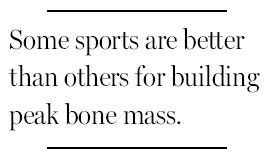For strong bones, an early start is key
Updated: 2013-09-08 07:39
By Jane E. Brody(The New York Times)
|
|||||||
Most people don't think about their bones until it is too late to protect against serious bone loss and resulting fractures.
Researchers say concern about the strength of one's bones should start in childhood and continue through adolescence, when the body builds most of the bone that must sustain it through life.
By age 20, girls have gained between 90 and 96 percent of their peak bone mass. For boys, the peak occurs a few years later.
About 26 percent of total adult bone is accrued in two years around the time that bone mass increases the most - at age 12.5 in girls and 14.1 in boys. The amount of bone added during those two years is about the same as what is lost between ages 50 and 80.
Lifelong studies have not been done, but the best evidence strongly indicates that increasing peak bone mass in childhood by just 10 percent could delay osteoporosis, especially in postmenopausal women, by about 13 years.
Although nothing can be done about the three factors with the greatest influence on bone mass - age, gender and genetics - two others under personal control can make the difference between suffering crippling fractures in midlife and escaping the effects of osteoporosis until after age 90. Those are physical activity and the bone-building nutrients, calcium and vitamin D.
While the focus here will be on the effects of exercise, it should be noted that calcium consumption by adolescent girls is often seriously inadequate, compromising their ability to build strong bones that will last a lifetime.

Exercise affects bone strength in two ways: in response to the pressure of gravitational forces like those experienced when walking, running or jumping, and in reaction to the stress exerted by muscle contraction.
On average, active children and adults have higher bone mineral density and reduced risk of fractures compared with their inactive counterparts, Dr. Kirk L. Scofield noted last year in Current Sports Medicine Reports.
But some activities are better than others. Studies have found that the bone mineral density of young endurance runners is lower than that of sprinters, gymnasts or ball sports athletes. In fact, those engaged in endurance and non-weight-bearing activities sometimes have weaker bones and a greater risk of fractures, both while actively competing and later in life, than their inactive peers.
"Repetitive stress can tear down bone," Dr. Scofield said. "It's not that running, walking, cycling or swimming are bad. They're just not as good for bone strength as other types of athletic activities."
Bones, he said, seem to respond best to a combination of stress, rest and variety.
Dr. Scofield said that the most effective form of stress on bones is that which works against gravity and starts and stops, as happens when playing soccer, basketball, or tennis; doing gymnastics or dancing; using resistance equipment; or lifting weights.
Dr. Scofield's advice is to encourage children to play actively, and to avoid pressuring them to be too thin.
Children ages 4 through 8 should consume 800 milligrams of calcium daily and those 9 through 18, 1,300 milligrams. If children are not getting enough calcium from their diet, Dr. Scofield recommends that they take a calcium supplement with vitamin D, which is needed for the body to absorb and use the calcium.
Children ages 1 through 18 need 800 International Units of vitamin D daily. Most vitamin D is obtained from sunlight, but the widespread use of sunscreens has greatly reduced this source, so a supplement may be essential.
The New York Times
(China Daily 09/08/2013 page10)